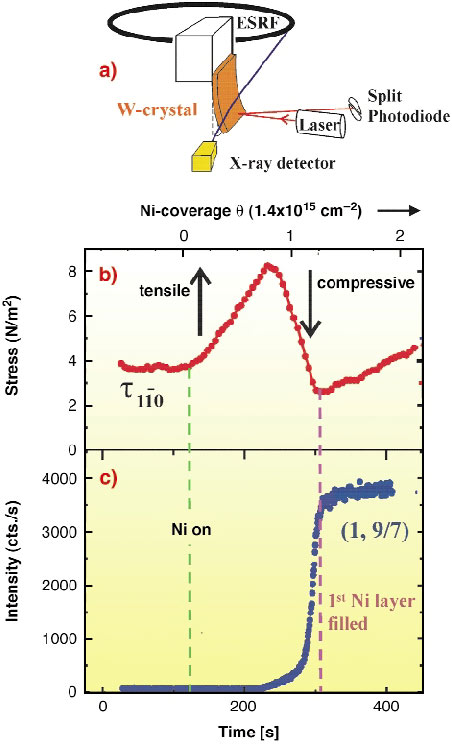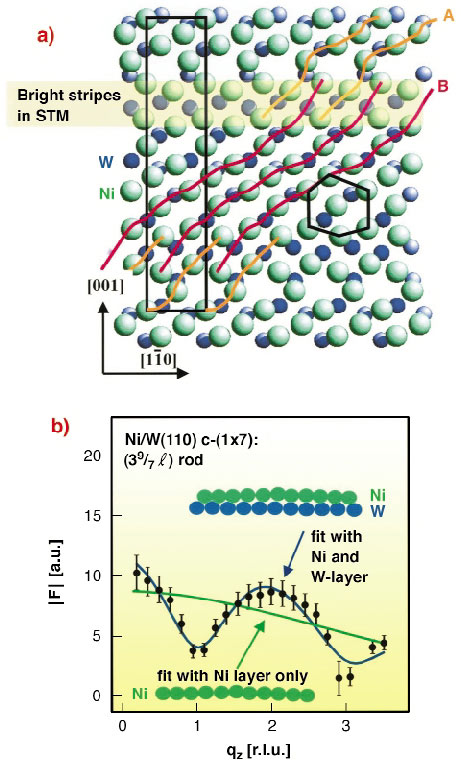- Home
- Users & Science
- Scientific Documentation
- ESRF Highlights
- ESRF Highlights 2003
- Surface and Interface Science
- Unusual Surface Reconstruction and Stress in Ni/W(110)
Unusual Surface Reconstruction and Stress in Ni/W(110)
In studies of metal adsorption on the Mo-and W (110) surfaces it has been a common approach to neglect the question of whether there is a substrate relaxation or not. Furthermore, these surfaces are prototype examples for the study of the relation between geometric surface structure and surface mechanical stress. Using surface X-ray diffraction (SXRD) on ID03 we find a Ni-induced reconstruction of the W(110)-surface and directly correlate this to giant compressive stress measured simultaneously using optical laser beam deflection from the sample surface.
A 0.2 mm thick W(110) crystal was clamped at one end to allow free bending [1]. During Ni deposition, the crystal curvature and a SXRD intensity characteristic for the superstructure were measured simultaneously (Figure 95a). The emergence of the c-(1x7) superstructure [2] coincides with the formation of compressive stress at t > 220 equivalent to 0.8 ML Ni-coverage (Figures 95b and 95c).
 |
|
Fig. 95: Simultaneous measurement of stress and X-ray intensity. (a): experimental setup, (b): stress vs. Ni-coverage, (c): SXRD intensity vs. Ni-coverage. |
After saturation of the c-(1x7)-reflection intensity (![]() = 1.3 ML ~ 310 s) the structure analysis using 144 reflections was carried out (structure model in Figure 96a). Both, Ni and W-atoms contribute to the reflections and give rise to an oscillatory intensity distribution along the rods (qz). Only a slowly varying intensity would be derived considering one Ni layer only (Figure 96b). In Figure 96a several unit cells (one highlighted by the rectangle) are shown. Ni-and W-atoms are represented as green and blue balls, respectively. Ni-atoms form a distorted hexagonal dense layer as indicated by the hexagon. The most important feature of the structure is the pronounced shift (up to 0.5 Å) of the first layer W-atoms out of their bulk positions along [1-10]. Ni-atoms are close to bridge sites forming 25 Å long alternating Ni-W-Ni chains (labeled as A and B). Where the chains overlap (see horizontal bright stripe) the Ni-atoms are located 0.3 Å above those in the rest of the unit cell explaining the contrast observed in STM [2].
= 1.3 ML ~ 310 s) the structure analysis using 144 reflections was carried out (structure model in Figure 96a). Both, Ni and W-atoms contribute to the reflections and give rise to an oscillatory intensity distribution along the rods (qz). Only a slowly varying intensity would be derived considering one Ni layer only (Figure 96b). In Figure 96a several unit cells (one highlighted by the rectangle) are shown. Ni-and W-atoms are represented as green and blue balls, respectively. Ni-atoms form a distorted hexagonal dense layer as indicated by the hexagon. The most important feature of the structure is the pronounced shift (up to 0.5 Å) of the first layer W-atoms out of their bulk positions along [1-10]. Ni-atoms are close to bridge sites forming 25 Å long alternating Ni-W-Ni chains (labeled as A and B). Where the chains overlap (see horizontal bright stripe) the Ni-atoms are located 0.3 Å above those in the rest of the unit cell explaining the contrast observed in STM [2].
 |
|
Fig. 96: Structure model for Ni/W(110) (a) and calculated super-lattice intensity along one rod for a one (Ni) and two (Ni/W) layer model (b). The data are shown as symbols. |
In summary, our results elucidate the relation between compressive stress and the c-(1x7) structure in Ni/W(110) involving substantial substrate reconstructions. So far it has been assumed that the substrate surface is structurally "inert" in all studies of surface and in surface dynamics on the W-and Mo (110) surfaces. Thus, it appears tempting to state that, in general, unusual compressive stress of adsorbate-covered surface structures might indicate "unusual" surface structures not considered so far.
References
[1] D. Sander, A. Enders and J. Kirschner, Europhysics Lett. 45, 208 (1999).
[2] D. Sander, C. Schmidthals, A. Enders, and J. Kirschner, Phys. Rev. B 57, 1406 (1998).
Principal Publication and Authors
H.L. Meyerheim (a), D. Sander (a), R. Popescu (a), J. Kirschner (a), O. Robach (b), S. Ferrer (b) and P. Steadman (c), Phys. Rev. B 67, 155422 (2003).
(a) MPI f. Mikrostrukturphysik, Halle (Germany)
(b) ESRF
(c) Diamond Light Source Ltd., Oxfordshire (UK)



